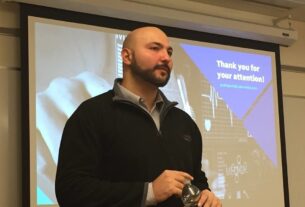By Axel Barceló
Silicon Valley is renowned across the world as a mecca for technological innovation. In February, I had the opportunity to go there to take part in the FutureMed program at Singularity University (SU), an academic institution founded by Google, Cisco and other companies. Located on the NASA campus, its objective is to “gather, educate and inspire leaders, providing them with the tools to face humanity’s biggest challenges.” FutureMed is a personalized program that focuses on the cutting edge technologies that are going to revolutionize the practice of medicine and radically transform approaches to healthcare and the biomedical industry over the next decade.
Excited by what I was about to experience over the next 6 days, I received an unconventional welcome when I arrived at the SU campus: a robot greeted us and gave us our first instructions about the lodging, schedule and other relevant details. The first scheduled activity consisted of a tour of the NASA Research Park, one of the 10 centers run by the organization, where R&D activities have been carried out for more than 60 years to serve the objectives of the United States space program. Since 2002, the center has built links with academic, industrial and non-profit organizations to stimulate innovation and education in the scientific and research disciplines that are fundamental for space exploration, such as astrobiology, computing, biotechnology and nanotechnology.
In the afternoon, we attended a welcome talk given by Dr. Daniel Kraft, Executive Director of FutureMed. This young inventor, businessman and medical-scientific innovator from Stanford and Harvard, gave a quick rundown of the scheduled activities and an introduction to the technologies to which we were going to be exposed over the next few days, which included artificial intelligence, robotics, mobile health, 3D Printing, nanomedicine and genomics. This is the third consecutive year that the program has taken place and of the over 500 applications received, 90 participants were selected from over 35 countries. All of them had an excellent academic record and successful professional careers, representing a perfect opportunity to create a network of contacts and to hear some extremely interesting stories.
Dr. Kraft, who during his talk was holding a device that displayed his vital signs in real time, spoke about how cellphones are becoming continuous monitoring devices, allowing people to lead healthier lifestyles (for example, monitoring of glucose levels, blood pressure, stress levels, arrhythmia, etc.) He also spoke about the “Era of prescription apps (applications for mobile devices)”, speculating on a future in which apps would be prescribed in the same manner as we now prescribe medications, how electronic games are being used to change lifestyles, laboratories in a chip, artificial intelligence such as Watson and several other issues regarding the medicine of the future. After a workshop in which each team had to show their skills at building structures from spaghetti and marshmallows, we had a presentation by Dr. Peter Diamandis, one of the Founders of the Singularity University.
Dr. Diamandis’ interesting and optimistic view of the future showed how exponential technologies are going to help us to make advances over the next two decades that weren’t available to us in the last 200 years. According to him, we will soon have the ability to cover the basic needs of each man, woman and child on the planet. His theory is based on Moore’s law and exponential thinking. What does that mean? That technology developed in the past has allowed us to develop the technology of the future in an exponential manner and will continue to do so. Exponential growth is disruptive. According to Peter, we aren’t used to thinking about how technologies that grow at these levels are going to impact our future, but that thinking about this will be key to creating a better future.
One example of exponential technology can be seen on CNN when the president of Rwanda said “In 10 years, what had been an object of luxury and privilege, the cellular telephone, has become a necessary good in Africa”. Currently, on this continent cellphones are connecting millions of people in a world where they didn’t exist before 2007.
On the second day, Brad Templeton made his presentation. Brad is a Committee Member at the Foresight Nanotech Institute, the President of the Board of the Electronic Frontier Foundation 2000-2010 and currently works at Google on a project that is seeking to develop the car of the future. If you ask what this has to do with medicine, the answer might lie in the fact that 1.2 million people die in car accidents across the world every year and this generates a cost of 230 billion dollars. Imagine what an impact it would have on world heath if road accidents were made a thing of the past. A car with Google sensors is seeking to achieve this with 360 degree vision created by 64 lasers that are projected in a circle, providing information about everything around them, in addition to GPS and detection sensors. The car has been travelling for over 3 years across three states and has covered 300,000 miles.
Another extremely interesting presentation was that by Martin S. Kohn, who demonstrated how AI/WATSON has the potential to modify medical practices. The key to this supercomputer lies in its ability to find meaning in “unstructured data”, understanding the nature of language, not just the meaning. It has the ability to adapt and learn from specific situations, using the knowledge it learns to build hypotheses and then assign values to each of them before deciding which is the best option to take. In healthcare treatments we don’t just expect a single response but various options. Watson would not be a decision maker but would understand the nature of the question and prepare responses so that the doctor can then choose the best option.
One of the concepts that is currently in vogue in healthcare trends is Big Data. Eric Rasmussen spoke about Global Health and how, through the use of Big Data, information can be obtained from different resources and monitoring devices so as to improve healthcare treatment. A similar concept is applied by Global Public Health via the Global Pulse, which is trying to analyze the “vital signs” of a given region to predict when a catastrophe might happen. José Gomez Marquez from MIT, gave precise indications of the parameters for the design of a medical device for global health: secure, robust, durable, cheap, reusable, exact, reliable, mobile, connected, intelligent and plug and play. One of the examples that he exhibited was a product called MEDIKits (Medical Education Design Invention Kits) which are medical kits that promote innovation and creativity in healthcare professionals. These devices demystify medical technology and provide suitable tools with which professionals can develop their own technological solutions.
How far can neuroscience go with the support of technology? This was the question considered by Adam Gazzaley. This specialist in Neuroscience and Gamification spoke about his research based on the use of games to improve or increase the cognitive capacity of human beings. He noted that the great problem with trying to improve cognition is that it is generally done at a pharmaceutical level, but that a multi-modular treatment based on the use of games could be more effective.
Marc Goodman’s presentation on the crimes of the future gave me the impression that science fiction plots might very well become a reality sooner than we think. Goodman explained his vision of the main cyber-attacks of the future:
• Hacking of healthcare organizations and patient information.
• Hacking of implantable electronic devices.
• Hacking of insulin pumps for diabetes patients and administering lethal quantities.
• Hacking the genome code of a virus and so increasing its virulence.
• Obtaining DNA and creating synthetic sperm (“…imagine the scandal if the DNA of a president were obtained”).
Following on from the ideas of Peter Diamandis, another of the founders of Singularity University, Ray Kurzweil, spoke about exponential thought and noted how present day technology has been able to decode the human genome. He thus believes that we are experiencing a biotechnological revolution in which we are going to treat health and medicine as though they were software. “…Medicine is becoming technological information. Hacking a genetic code means being able to reprogram biology…”
The specialist in bio-computing and genomics, Andrew Hessel, stood in front of the auditorium and asked “Is biology the great new technology industry?” After listening to his talk, it would seem that it is. Hessel is exploring the possibility of creating living creatures through the use of technology. To understand this concept, one must understand that biology is now digital and that DNA can be imprinted. DNA contains a code with genetic instructions that make up a human being. So, if DNA can be digitized this means that it can be hacked but also imprinted. Another interesting concept was synthetic virology which could be used to program different tasks. So a virus can be programmed to perform specific roles such as attacking a cancer cell, bacteria, etc.
A few minutes later, Raymond McCauley explained how medical research is changing drastically thanks to the invention of 3D bioprinters that can print living structures such as blood vessels or skin tissue cell by cell, thus revolutionizing biomedical engineering.
In addition to hearing brilliant speakers and sharing in the innovative environment, I had the opportunity to try out some of the major advances that are revolutionizing medicine. So, in a space set aside to test technological developments, I was able to simulate an operation using a Da Vinci robot, a surgical system that improves results by modifying surgery in three ways: 1) by simplifying existing minimally invasive procedures; 2) by making it possible to use minimally invasive techniques in complex surgical procedures; 3) by making more minimally invasive surgical procedures possible.
According to Catherine Mohr, a robotics specialist, the technology currently exists to operate on tissue at a microscopic level. This might not be useful for diseases at advanced stages but with the application of exponential technologies to detect diseases early, removing specific tissues or attacking the problem at the cellular level could be the future of surgery, preventing any further development of the diseases. After 6 days immersed in the future of healthcare, in an exciting environment where speakers are constantly challenging you to think beyond established boundaries, I can’t wait to transmit these experiences to all those who wish to develop enterprises that improve the quality of life of millions of people.
Healthcare as we know it is undergoing radical change, watershed moments are coming and we are all on the starting line for creating innovation in healthcare. It all depends on us.


